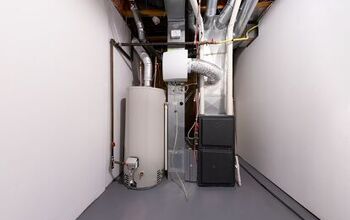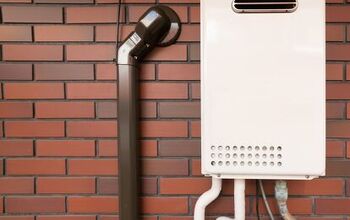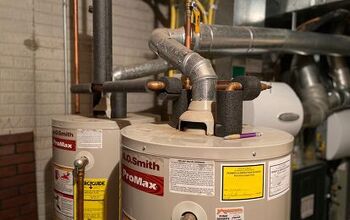Can You Transport A Water Heater On Its Side? (Find Out Now!)

A water heater helps to heat the water in your house, so you can shower with warm water or use hot water to clean your dishes. Although a water heater is a major appliance, these units do not have a long lifespan, with many only lasting about ten years. Replacing a water heater is a simple job, but moving your new water heater is the hardest part of the entire water heater installation process.
While many professionals advise against moving a water heater on its side, there is no real difference between moving a water heater on its side or standing up. While a water heater laying on its side can roll, damaging the internal liner, a water heater left to stand can tip over and break. As long as you use adequate protection, moving your water heater on its side is perfectly safe.
When moving a water heater, it is essential to ensure that you have enough space in your vehicle to transport the unit properly. Water heaters come in many sizes, so be sure to check the overall dimension before purchasing a new water heater. The best way to transport a water heater is with a pickup truck, although an SUV or large car may work for small water heaters.
With the correct strapping and optional bracing, a pickup truck is the best way to move a water heater, either laying on its side or standing vertically in the truck’s bed.
Do You Need Water Heater Installation or Replacement?
Get free, zero-commitment quotes from pro contractors near you.

How Can I Transport a Water Heater Vertically?
One method that professionals often prefer is to move your water heater vertically, standing up. Often, homeowners will find specific instructions that suggest this is the only way and safest way to transport a water heater. To move your water heater vertically, you must:
Step 1: Load Water Heater
Using a hand truck or a dolly, wheel the water heater to your truck. With a friend, lift the water heater gently onto the bed of the truck, ensuring to protect the outside of the heater from dings and scratches.
Step 2: Move to Corner
Next, gently slide the water heater to the back corner of the truck bed so that it is supported on two sides of the heater.
Step 3: Strap In Place
Using straps or bungee cords that are rated for heavy loads, strap the water heater in place. Make sure to strap the water heater in multiple locations to prevent the heater from tipping over. Ensure the straps are tightened down completely.
Step 4: Test Drive
Drive just a short distance. Get out of the vehicle and double-check your straps. If any have started to loosen, retighten and continue driving.
Step 5: Carefully Unload
Once you have reached your destination, carefully unload the water heater, ensuring you keep the heater upright the entire time.
Step 6: Wheel Into Place
Using the hand truck or dolly, wheel your new water heater into place. Be sure to use caution when navigating tight turns or to go down the stairs. Having a friend with you to relocate the new water heater can help with the heavy lifting.
How Can I Transport a Water Heater Horizontally?
Although many people will suggest that it is dangerous to move a water heater horizontally, it is perfectly acceptable. Moving a water heater vertically, standing up runs the risk of tipping over and damaging the water heater. If adequately padded and protected, moving a water heater horizontally, or laying on its side, can actually minimize the chance of damage.
To move your water heater horizontally on its side, you should:
Step 1: Find a Flat Spot
To prevent damage, you’ll need to find a flat spot to lay your water heater down. For small heaters, you can fold down the seats of your car or SUV. For a truck, you can find a flat area in the bed of the truck. Sometimes, using lumber supports can help prevent rolling (more below).
Step 2: Fasten With Ratchet Straps
Use ratchet straps to secure the water heater into place and prevent movement. If the water heater is in the box, make sure to ratchet straps in two areas. You’ll want to put the straps 2 inches from the top of the box and 2 inches from the bottom of the box.
Step 3: Use Padding
To ensure your water heater stays safe, secure the box with additional padding. There is a chance the heater can shift as you drive, so items like old comforters or moving blankets can help add more cushioning and support.
Step 4: Build Supports (Optional)
If your water heater is no longer in a box, building lumber supports can help prevent the round tank from rolling. Create a brace for the top and bottom of the water tank that is the exact diameter of the tank to cradle the water heater and prevent rolling.
How Much Does a Water Heater Weigh?
Ensure that you have enough support from a friend or professional to help you move your water heater. A standard 50-gallon water heater can be extremely heavy and can weigh an average of 140 pounds. Ensure that your dolly or hand-truck can support this amount of weight, and you can navigate any stairs or tight turns throughout your home while getting your water heater into place.
What Tools and Supplies Do I Need to Move a Water Heater?
Transporting a new water heater to your home will require just a few simple and essential tools that most DIY homeowners have on hand. To safely move your water heater, you will want to have:
- Dolly or Handtruck
- Bungee Cords, Straps rated for heavy loads
- Padding, covers, old blankets
- A friend to help with heavy lifting
Once you have successfully transported your new water heater to your home, be sure to have the right tools to disconnect and reconnect your new water heater. You’ll need a garden hose, bucket, screwdriver, wrench, and pipe cutters to be able to uninstall and reinstall your new system.
Can a Water Heater Fit In My Car?
Once you purchase your water heater, you will need to find adequate transportation to bring your water heater home. Most midsize cars or larger SUVs should be able to accommodate a tankless water heater. These models are usually under two feet tall and can adequately fit in a car’s trunk or back seat. Some smaller water heaters, like a 30-gallon water heater, may fit inside a midsize or large car.
You may need a large SUV or pickup truck for larger water heaters that are 40 or 50 gallons. A pickup truck will allow you to transport your water heater both vertically or horizontally, depending on which method works best for you. Always be sure to follow the proper steps to transport your water heater safely to avoid damage.
How Tall Is a Water Heater?
If you are attempting to move a water heater yourself, it is important to understand the overall dimensions to ensure a sound and secure transportation option. Below are some of the typical dimensions for various water heater sizes.
| Manufacturer | Capacity (In Gallons) | Height |
| AO Smith Tall | 40 Gallon | 60.5 inches |
| AO Smith Short | 40 Gallon | 49.75 inches |
| AO Smith Lowboy | 38 Gallon | 32 inches |
| AO Smith Tall | 50 Gallon | 60.75 inches |
| AO Smith Hybrid | 50 Gallon | 63 inches |
| Rinnai Tankless | —- | 26.4 inches |
To be safe, assume that any water heater will require at least 5 feet of clearance to transport your heater standing vertically. If you are tight on space, using a lowboy or short model for a water heater may be an excellent choice. These models are significantly shorter, measuring just a little over four feet tall and a little under three feet tall, respectively.
Do You Need Water Heater Installation or Replacement?
Get free, zero-commitment quotes from pro contractors near you.

Related Questions
How Much Does It Cost To Move a Water Heater?
Moving a water heater from one location to another can be a costly process, depending on where in the home you plan to relocate your water tank. Assuming there is access to the new location with a ventilated door, the cost to move a water heater will run about $500. However, suppose there is extensive new gas and water plumbing involved. In that case, it will probably cost about $500 to have new lines run, in addition to another $500 to have the water heater adequately moved and connected.
How Much Does a Water Heater Cost?
The cost of a water heater will largely depend on the size and the type of water heater you purchase. Generally, instantaneous hot water systems will be more expensive, and gas water systems tend to be more pricey than electric. For comparison, a standard electric water heater may cost $525, while a gas standard system may cost $880.An electric continuous hot water system may run $700, while a gas continuous hot water system may run $1,200 depending on the model. Other water heater systems that are more advanced will cost more. For example, a solar hot water system may run upwards of $5,000 for the new unit and installation.
Related Articles

We are a team of passionate homeowners, home improvement pros, and DIY enthusiasts who enjoy sharing home improvement, housekeeping, decorating, and more with other homeowners! Whether you're looking for a step-by-step guide on fixing an appliance or the cost of installing a fence, we've here to help.
More by Upgraded Home Team



























